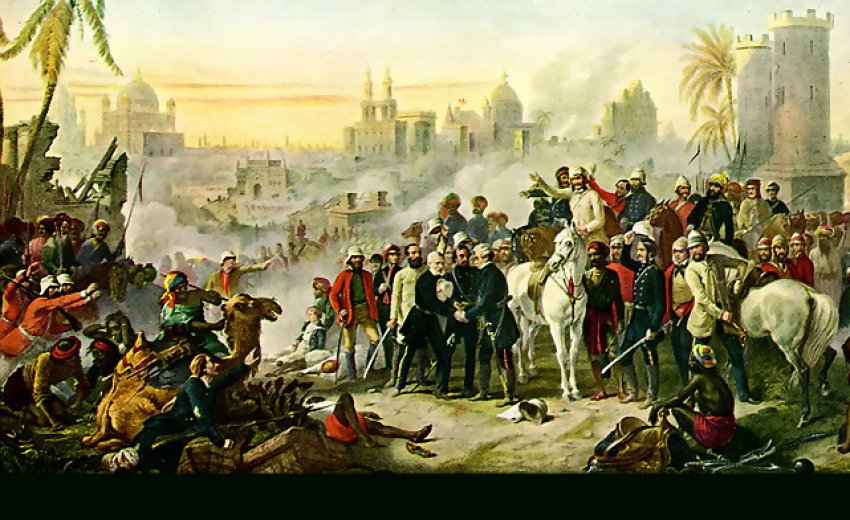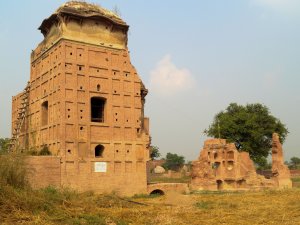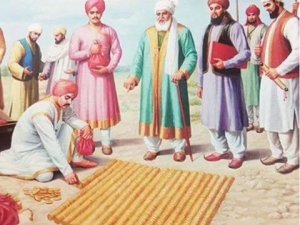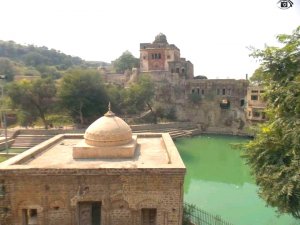Background
In 1957 the Government of India decided to commemorate the Centenary (1857-1957) of the 'Revolt of 1857'. A committee by the name of Indian Freedom Struggle Centenary (1857-1957) Souvenir Committee based at New Delhi was formed. During the seminar, the general consensus was that "Indian Struggle for freedom (1857) failed as the Sikhs betrayed and sided with the British". The Secretary to the Committee, his letter dated 13th June 1957, asked Dr Ganda Singh to rebut the charge, is possible. Accordingly, Dr Ganda Singh wrote number of articles in the Tribune Newspaper during the months of August & September 1957. However, even after the lapse of 60 years same allegations are made and more recently propagandist on social media takes pot-shots at Sikhs on this issue.
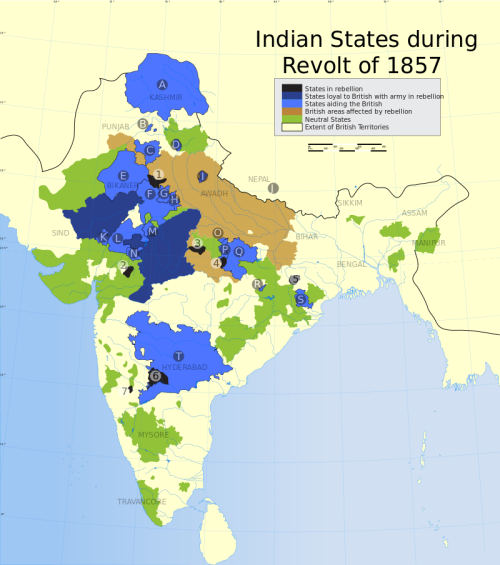 Sikh population in 1857
Sikh population in 1857
Dr Ganda Singh states that Sikhs were about 1% of population of united (or pre-partitioned) India. The rest of 99% could have arisen and negated the effect of 1%. In Punjab, Sikhs were not more than 10% during this period. Even this figure is on higher side when we compare them with the census figure of 1881. Did the rest of 90% namely Hindus and Muslims rose to the rebellion? If not, why? How many people or states rose in rebellion? Let's examine these questions
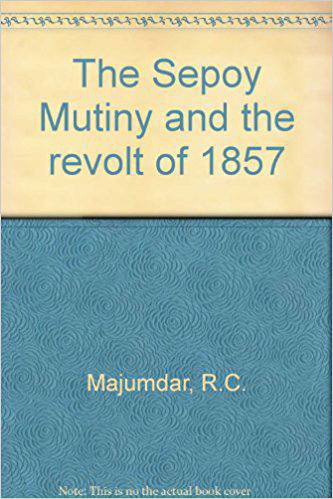 Who did not join the Rebellion?
Who did not join the Rebellion?
I am quoting two eminent historians and their works published in 1957. Dr Ramesh Chandra Majumdar wrote "The Sepoy Mutiny & Revolt of 1857". Majumdar is considered more of a 'right-wing' historian. He is particularly liked by the 'Nationalists'. Dr Surendra Nath Sen book 'Eighteen Fifty-Seven' was commissioned by Government of India and it could be considered as part 'Left-wing Marxist' historian work. They were great historians and for the purpose of this discussion, their contrasting background philosophy will give readers a balanced picture. Both works have used a lot of contemporary and original sources. Let's examine what these esteemed historians have to say about the role of other states in the revolt.
Rajasthan: Dr Majumdar states "The people remained quiet and the Rajput chiefs particular the Raja of Jodhpur helped the British. The only exception was Thakur Kusal Singh, the chief of Ahua who had some specific grievances against the British"
Bengal: Dr Majumdar writes "Bengal was practically unaffected by the Mutiny with the exception of two sporadic outbursts at Dacca & Chittagong" (both are now in Bangladesh).
Bombay Presidency: The present states of Gujarat, Maharashtra & Sindh (now in Pakistan) were part of it. Dr Majumdar notes "In general the Bombay army remained loyal but there were some sepoys who shared the feeling of their comrades in Northern Indian. Attempts at mutiny failed at Ahmadabad and Hyderabad in Sindh, and though a mutiny broke out in Karachi, it was easily put down"
South India: Sen writes "The Presidency of Madras remained unaffected all through, though some slight signs of restlessness were perceived in the army." The educated community unreservedly ranged itself on the side of law and order and condemned the rising in unambiguous terms".
Maratha ruler Sindhia of Gwalior, Holkar of Indore and Gaikwad of Baroda actively helped British despite the fact that Nana Sahib, adopted son of Peshwa Balaji Baji Rao II had plunged into the rebellion. Ranbir Singh Dogra, ruler of Jammu & Kashmir also assisted British in subduing the revolt.
JC Marshman in 'History of India' published in 1867 strongly advocated continuing the princely states of India based on their help in suppressing the revolt. "But so exemplary was their loyalty to the British Government in the days of its extremity, that the advocates of native dynasties have adduced it as one of the strongest arguments for maintaining them."
Why Sikhs did not join?
Dr Ganda Singh has rightly stated that Sikhs were neither approached nor consulted to join the revolt. Dr Majumdar has rebuffed any possibility of planning on the part of any princely ruler or Bengal soldiers to initiate a revolt of 1857.
The rebel sepoys had declared Bahadur Shah Zafar, scion of Mughal family who lived on British pension and whose influence did not went beyond Red Fort. This was not acceptable to Sikhs as Mughals had a history of persecuting Sikhs. The list is rather long.
- a) Martyrdom of fifth Guru, Arjan Dev by Emperor Jahangir in 1605.
- b) Martyrdom of ninth Guru, Tegh Bahadur by Emperor Aurangzeb in 1675.
- c) Execution of younger sons of Guru Gobind Singh by Mughal governor of Sirhind in 1705.
- d) Royal edict to kill Sikhs on sight by Emperor Bahadur Shah in 1710.
- e) Royal edict to kill Sikhs on sight by Emperor Farrukh Siyar and execution of Banda Bahadur & 700 Sikhs in Delhi in 1716.
- f) Killing of Sikhs & putting a price on head of a Sikhs and persecution under Mughal Governors of Punjab namely Zakriya Khan, Yahya Khan till Mir Mannu's death in 1752.
Mir Mannu later became Governor of Lahore under Ahmed Shah Abdali who was himself involved in destroying Harmandar Sahib, Amritsar twice and killing more than 25,000 Sikhs in a single day. I would clarify here that he was not a Mughal but Afghan ruler who invaded north India no less than 8 times. All these events have been well covered in 'History of the Sikhs' by Dr Hari Ram Gupta.
British stratagem
The British conveniently reminded Sikhs of the martyrdom of Guru Tegh Bahadur, when rebel sepoys declared Bahadur Shah Zafar, descendant of Mughal Emperor Aurangzeb as the ruler of India. Across Trans- Sutlej Punjab posters were pasted reminding Sikhs of the Mughal atrocities.
The British also reminded Sikhs of a prophecy (of dubious origins) that foretold the sack of Delhi (ruled by Mughals) by the followers of the Sikh Gurus. Sikhs were assured that the prophecy would come true under the British leadership. Most Sikhs readers will be aware that under the leadership of two Jassa Singhs (Ahluwalia & Ramgarhia) and Baghel Singh, Sikhs had successfully conquered Delhi 74 years ago in 1783. Dr Hari Ram Gupta laments that Baghel Singh declined to be the Regent of the Mughal Emperor which could have paved way for Sikh rule in North India. The great historian also commends the conviction of Sikh Sardar. Needless to say, the British won the battle of hearts and minds over Sikhs.
Rebel Bengal army
There was no love lost between Punjabis (particularly Sikhs) and soldiers of British East India Company who fought two Anglo Sikhs war in 1845/46 and 1848/49. These soldiers were known as Purbehias (Easterners) or Hindustani. They were mostly Muslims, Brahmins & upper caste Hindus from Uttar Pradesh. The Sikhs and Punjabis had send feelers to these soldiers number of times during two Anglo-Sikh wars asking them to join them and ousted British from the country but to no avail. Consequently the Punjabis blamed them for their defeat. The attitude of Hindustani soldiers and treatment towards Punjabis and Sikhs was very bad. As these soldiers had rebelled, it evoked little sympathy from the Punjabis. The British were able to exploit this distrust.
Absence of Sikh leader
Dalip Singh, the son of Maharaja Ranjit Singh was taken to England by the East India Company. His mother Maharani Jind Kaur was living in exile in Nepal. Chattar Singh and his son Sher Singh Attariwala who led the second Anglo Sikh war in 1848-49 were exiled in Banaras. The former has already died. Sher Singh died in 1858. Other prominent leaders of the second Anglo-Sikh war were either dead or forced to live an isolated life. Bhai Maharaj Singh who was exiled to Singapore had passed away in 1856. Baba Bikram Singh (Bedi) of Una another leader was forced to leave Una and spend rest of his life in Amritsar. All these leaders and those who were expected to cause trouble were under strict surveillance by the British throughout the revolt.
Extend of the revolt
The Sepoys of Bengal army revolted at number of places but in most places the people and the local rulers kept aloof. Dr Majumdar writes that the extent of the revolt where people also participated was limited to Uttar Pradesh, Delhi (& neighbouring areas) and parts of Central India. The revolt took a national character in these areas. Hence he writes that he has chosen the title of his book 'Sepoy Mutiny' and Revolt of 1857'. Dr Sen & Dr Majumdar have produced letters of Nana Sahib and Rani Laxmi Bai written to British after the revolt promising loyalty and redressal of their personal grievances. The former was an adopted son of Peshwa and wanted recognition and pension of his father. The latter wanted the same for an adopted son. They were not unjust demands and Lord Dalhousie much maligned policy of 'Doctrine of Lapse' where a state would pass on to the British if they did not had a natural heir, was responsible for forcing them and Awadh (in Uttar Pradesh, which was annexed on superficial grounds) to join the revolt.
Attitude of general public
Maulana Azad a proponent of Hindu-Muslim unity but a scholar captures the attitude of general public in the lengthy forward to the book written by Dr Sen. Tatya Tope, one of very few people who fought not due to personal grievances, joined revolt due to his loyalty to his master Nana Sahib. He failed to find a solitary place for refuge when he reached Maratha heartland and was betrayed by a friend.
"They were very often mere spectators of the struggle and lent their support to whichever side was more powerful at the moment. An idea of their attitude may be gained from the fate which overtook Tatya Tope. When he was finally defeated, he resolved to struggle back across the Narmada into Madhya Pradesh. He was convinced that once he reached the Maratha region, the people would offer him support. With almost superhuman courage and tenacity, he eluded his pursuers and did cross the Narmada. When he reached the other bank, he could not find one village which would give him shelter. Everybody turned against him so that he had to fly again and resort to the forests. It was a professed friend who finally betrayed him while he was asleep."
Another close confidante of Nana Sahib was Rao Saheb. Dr Sen writes that "Rao Saheb was betrayed, not by a Rajput, but by a man from Maharashtra. It was learnt that Rao Saheb was in residence at Chenani in the Jammu territory with his wife and child. Mr. McNabb, Deputy Commissioner of Sialkot, at once proceeded to Jammu to arrange for his arrest which was effected without any trouble."
National or first war for independence
In early part of 20th century, a number of Indians wrote about revolt of 1857 as 'first war for independence' and glorified the Indian rulers who fought in the revolt as 'freedom fighters'. It was perhaps the need of the hour to instil nationalist sentiment among the people of the country. But this is not true.
Even in Central India where the revolt had popular following, there were number of instances where Hindus and Muslims had major disputes and skirmishes. Hence Dr Majumdar has stated "To regard the outbreak of 1857 as either national in character or a war for independence of India betrays a lack of true knowledge of the history of Indians people in nineteenth century."
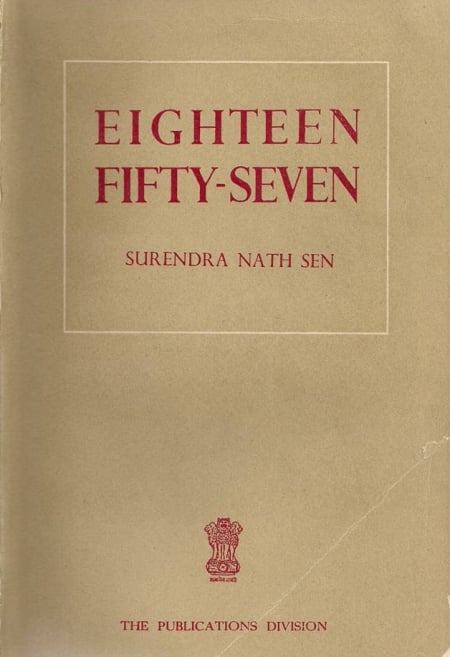 Dr Sen is slightly more sympathetic "Outside Oudh and Shahabad there is no evidence of that general sympathy which would invest the Mutiny with the dignity of a national war. At the same time it would be wrong to dismiss it as a mere military rising. The Mutiny became a revolt and assumed a political character when the mutineers of Meerut placed themselves under the King of Delhi and a section of the landed aristocracy and civil population declared in his favour. What began as a fight for religion ended as a war of independence for there is not the slightest doubt that the rebels wanted to get rid of the alien government and restore the old order of which the King of Delhi was the rightful representative."
Dr Sen is slightly more sympathetic "Outside Oudh and Shahabad there is no evidence of that general sympathy which would invest the Mutiny with the dignity of a national war. At the same time it would be wrong to dismiss it as a mere military rising. The Mutiny became a revolt and assumed a political character when the mutineers of Meerut placed themselves under the King of Delhi and a section of the landed aristocracy and civil population declared in his favour. What began as a fight for religion ended as a war of independence for there is not the slightest doubt that the rebels wanted to get rid of the alien government and restore the old order of which the King of Delhi was the rightful representative."
Bengal army role in destroying Indian states
Dr Majumdar has rightly pointed out that the Bengal Army (consisting of Muslims & upper caste Hindus) was responsible for defeating Gorkhas, Marathas and Sikhs. After helping and assisting British to win whole to India (there were 7 Indian to 1 British soldier in Bengal Army), the Bengal sepoys mutinied for religious reasons. He writes that Anglo-Sikh war the most opportune time to revolt against British but Bengal soldiers helped British to defeat Sikhs and Indian leaders who revolted in 1857 were still friends with British at this stage. Dr Majumdar writes:
"In this connection a very important fact is often forgotten by those who claim the outbreak of 1857 as a national war of independence, for which patriotic sepoys shed their blood, and political leaders had been preparing grounds for a long time. The Panjab was conquered by the British with the help of the sepoys less than ten years before the outbreak of Mutiny. The battle of Chillianwala which proved the valour and heroism of the Sikhs, and their ability, under more favourable circumstances, to defeat the English, was fought in 1849, only eight years before the Mutiny. If there were really a movement for freeing India from the British yoke, obviously this was the most suitable opportunity. But we have not the least evidence to show that the Indian leaders like Nana Sahib and others mentioned above raised their little finger to help the cause of the Sikhs. The sepoys themselves, who are supposed to have sacrificed their all for the sake of their country in 1857, had not the least scruple to fight the Sikhs who were the last defender of liberty in India There are even allegations that the Sikhs entreated the sepoys to refuse help to the British, but in vain.
Although this cannot be definitely proved, it should have occurred to every sepoy, who had real love for his country, that by defeating the Sikhs he would only forge the last link in the chain by which India was being fettered by the British. It is difficult to resist the conclusion that the attitude and activities of the sepoys in 1849 certainly did not correspond to the patriotic fervour with which they are supposed to be endowed in 1857. Unless, therefore, we suppose that this sentiment was suddenly developed during the short interval of eight years, we can hardly regard the sepoys, who rebelled in 1857, as being inspired by the idea of liberty and freedom. Incidentally, the Sikh War also proves the absence, in 1849, of any serious conspiracy or organisation against the British, although, according to Sitaram Bawa, such conspiracy against the British was going on for many years in almost every native court. Surely the Sikh War would have been the most suitable opportunity, if ever there were any, which the conspirators should have taken "advantage of for organising a war of independence against the British."
Conclusion
The Sikh princely state of Patiala and others actively assisted British by sending their soldiers. Numerous Hindu princely states including Dogra, Hill Rajputs, Marathas (states of Sindhia, Holkar & Gaikwad), Rajputana and state of Travancore actively helped British in suppressing the revolt. So, why Sikhs are specifically targeted? Is it because they don't form a vote-bank outside Punjab?
It is very fashionable across the Raavi to paint the revolt as Muslim struggle to regain Empire where Hindus did not assisted them. The Nizam of Hyderabad, Nawab of Malerkotla, Karnal, Punjabi Muslims and Pathans, did not joined the revolt even when Bahadur Shah Zafar, scion of old Mughals was declared Emperor of India. These rulers and communities helped British to crush the revolt.
Sikhs are not devoid of patriotism. It seems Sikh contribution in freedom struggle against British is not taught outside Punjab. The history taught in schools across the country is based on establishment's concern to keep their vote bank happy. And Sikhs are not a vote-bank outside Punjab hence they are easy target. Before I end, I would explode another myth propounded by many that Sikhs actively helped British by joining their army. By WW2, Sikhs formed about 20% of the forces, the Punjabi Muslims & Pathans formed a third of all forces (33%) and remaining were all Hindus (about 47%). Let us start respecting history and do not misrepresent it against fellow countrymen and neighbours for petty gains.
References
Sen, S.N (1957). Eighteen Fifty-Seven. Delhi: Ministry of Information & Broadcasting
Majumdar, R.C (1957). The Sepoy Mutiny & Revolt of 1857. Calcutta: Firma K.L
Gupta, H.R. The History of Sikhs Vol 1 & 2. Delhi: Munshi Manohar Lal
Singh, Ganda (1969) The Indian Mutiny of 1857 & the Sikhs. Delhi: Gurdwara Parbandak Committee
